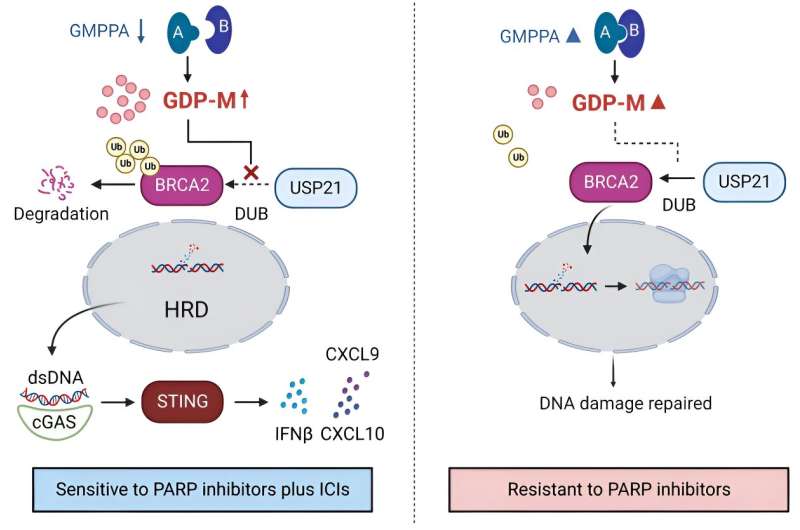March 22, 2024 feature
This article has been reviewed according to Science X's editorial process and policies. Editors have highlighted the following attributes while ensuring the content's credibility:
fact-checked
peer-reviewed publication
trusted source
proofread
Scientists consider fighting potentially lethal form of breast cancer with chemical produced by the disease

Triple negative breast cancer is the most aggressive subtype of the disease and is notorious for a poor prognosis, but scientists are working on a breakthrough method of converting these treatment-resistant tumors into a form that succumbs to therapy.
The new research, based on a deceptively simple concept, was conducted by scientists in China who turned to the metabolism of triple negative breast cancer to find a compound to treat the disease.
Medical researchers have long theorized that metabolites produced by triple-negative tumors are exploitable. Now, researchers at Fudan University in Shanghai, are on the path to doing just that—using a metabolite of the cancer as the linchpin in its treatment. The research is published in the journal Science Translational Medicine.
"We systematically analyzed triple negative breast cancer's metabolomics and identified a metabolite, guanosine diphosphate-mannose—GDP-M—that impeded homologous recombination repair," wrote Dr. Jia-Han Ding. The metabolite, Ding noted, potentiates anti-tumor immunity and blunts the ability of homologous recombination repair, which means GDP-M impedes a tumor's ability to repair breaks in its DNA.
Chemically, GDP-M is a nucleotide sugar that is a substrate for glycosyltransferase reactions in human metabolism. It is also produced metabolically by Escherichia coli and can be reproduced synthetically in the lab. Hence, the suggestion in the new paper by Ding and collaborators, that GDP-M can be used as an add-on treatment—a supplement—to cancer therapy.
The evolving approach not only suppresses tumor growth, according to lab studies conducted by the Shanghai team, but additionally boosts the effects of two approved cancer therapies. This suggests that the addition of the metabolite could be integrated into current treatment regimens for patients afflicted with this potentially lethal cancer, Ding and a large team of Shanghai-based investigators say.
Triple-negative breast cancer accounts for an estimated 10% to 15% of breast cancer cases in the United States and is a potentially deadly form of the disease because of its high metastasis risk. In the U.S., this form of breast cancer inexplicably, and disproportionately, affects African American and Hispanic women, studies have shown.
Doctors at the U.S. National Cancer Institute say triple negative breast cancer meets a strict clinical definition. These tumors do not have estrogen or progesterone receptors on cancer cell surfaces. Women with this form of the disease also do not produce the protein known as HER2.
Altogether, these three differences—no estrogen or progesterone receptors and the absence of HER2 protein positivity—comprise the "triple negative" definition. By contrast, effective treatment regimens exist for breast cancers that possess hormone receptors for estrogen and progesterone. And likewise, effective therapy also exists for breast cancers that are HER2-positive.
But while triple-negative breast cancers do not qualify for treatments that aid patients with other forms of the disease, doctors have found that not all triple negative breast cancers are equal.
To ferret out differences in triple negative breast cancers, pathologists have developed a way to score these types of tumors. Pathologists look for differences in "homologous recombination deficiency," which is when a tumor can't repair damaging breaks to its DNA strands. This inability is noted in the pathology report following studies of patients' biopsy samples. From these observations, doctors are able to differentiate one type of triple negative breast cancer from another.
Cancers with a high homologous recombination deficiency score often respond well to DNA-damaging drugs, while tumors with low deficiency scores tend not to have good treatment options.
Now, Ding and colleagues are offering a ray of hope as they pursue research focusing on the benefits that may result from GDP-M, a key metabolite that suppresses repair of tumor DNA. Using it as a supplement in their research, Ding and collaborators, theorized they could convert low-deficiency tumors to more treatable high homologous recombination deficiency cancers.
To determine if they were on the right track, Ding and colleagues first performed metabolic analysis with tumor samples from 401 patients with varying homologous recombination deficiency scores. These studies revealed that the metabolite GDP-M impeded DNA repair and raised deficiency scores, primarily by accumulating in tumor cells and promoting the degradation of the cancer-linked protein BRCA2.
"Triple negative breast cancers with high homologous recombination deficiency scores benefit from DNA-damaging agents, including platinum drugs and poly(ADP-ribose) polymerase—PARP—inhibitors, whereas those with low homologous recombination deficiency scores still lack therapeutic options," Ding said. "We sought to exploit metabolic alterations to induce homologous recombination deficiency and sensitize DNA-damaging agents in triple negative breast cancers with low homologous recombination deficiency scores."
After the study of human breast cancer cells, Ding and colleagues turned to a mouse model and exposed GDP-M sensitized tumors to DNA-damaging drugs, such as cisplatin, which boosted antitumor activity. Additionally, GDP-M potentiated the power of immune checkpoint antibodies and of PARP inhibitors, a class of targeted agents for breast cancer.
"Therapeutically, we illustrated that the supplementation of GDP-M sensitized DNA-damaging agents to impair tumor growth in both in vitro—cancer cell lines and patient-derived organoids—and in vivo, xenograft in immunodeficient mouse, models. Moreover, the combination of GDP-M with DNA-damaging agents activated STING-dependent antitumor immunity in immunocompetent syngeneic mouse models," said Ding.
The findings resulted in the conclusion that GDP-M could one day in the not-too-distant future lead to a therapy for those with the worst form of triple negative breast cancer. "We propose that GDP-M combined with PARP inhibitors is a new strategy to sensitize tumor cells to immune checkpoint inhibitor therapy," Ding concluded.
More information: Jia-Han Ding et al, Guanosine diphosphate–mannose suppresses homologous recombination repair and potentiates antitumor immunity in triple-negative breast cancer, Science Translational Medicine (2024). DOI: 10.1126/scitranslmed.adg7740
© 2024 Science X Network


















